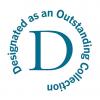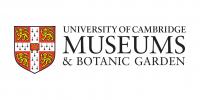
Submitted by Sara Steele on Tue, 15/06/2021 - 15:06
The University Museum of Zoology are set to launch their new summer exhibition, featuring artworks from three artists plus an original giant extinct elephant bird egg belonging to Sir David Attenborough.
The summer exhibition – entitled Breaking Point – explores the fragile nature of the world through a series of artworks made from a material that is also fragile: ceramics.
Three artists, Elspeth Owen, Jayne Ivimey and Mella Shaw will be exhibiting their work, all inspired by the natural world, among the Museum’s skeletons, preserved animals and taxidermy specimens. All three artists have a strong interest in the environmental movement and create ceramics that seek to engage, provoke and stimulate discussion about our relationship with nature and our impacts on it.
One of the artworks – by Cambridge-based Elspeth Owen – is a large clay egg which will be displayed together with an enormous elephant bird egg on loan from Sir David Attenborough. The elephant bird egg was rebuilt by Sir David Attenborough from scattered fragments of shell found while he was filming BBC’s Zoo Quest to Madagascar in 1961. The species was among the largest birds to have ever lived, reaching around three metres tall and weighing up to 450kg, more than triple the weight of a large ostrich. They were driven to extinction by the end of the 1600s. Owen has scattered the shards of a second ceramic “egg” through the Museum’s displays, as a reminder of how easily everything breaks, and how often there is a chance rebuild and mend.
Here is a video of Sir David Attenborough rebuilding the egg in the exhibition: https://youtu.be/ASJvktzfQ4g
Jayne Ivimey has sculpted the 67 species of British birds which now make up the county’s “Red List” of threatened birds – those that have suffered a severe decline of at least 50% in the breeding population and at least 50% reduction of the UK breeding range. Ivimey’s ceramic birds replicate the delicate specimens of bird skins in museum collections and will be displayed alongside them.
Mella Shaw’s installation, titled HARVEST, explores the impact that single-use plastics are having on our oceans. She has formed dozens of fish and “plastic” containers out of clay, highlighting that without drastic change, by 2050 there is predicted to be a greater weight of plastic in the oceans than fish. Across the globe the seabed is littered with ceramic vessels left there by thousands of years of human history – but in recent decades, plastic, similarly durable and cheap to produce, has superseded this natural material. The effect has been devastating and plastic pollution now threatens the very life of our oceans.
Jack Ashby, the Museum’s Assistant Director and one of the exhibition’s curators said, “Our natural history collections tell the story of hundreds of years of environmental change, and the artworks in our Breaking Point exhibition do the same thing in a different way, using a naturally fragile material. Putting this exhibition together with these three incredible, thoughtful artists, and our colleagues in the Cambridge Conservation Initiative, has allowed us to use the fragility of fired clay to explore ecological decline, ecosystem collapse and environmental change and uncertainty – some of the biggest challenges the world is facing right now. Placing the sculptures in and amongst our own animal specimens really heightens this point.”
The exhibition was supported by The National Lottery Heritage Fund and was created in partnership with the Cambridge Conservation Initiative (CCI).
CCI’s John Fanshawe, who co-curated the exhibition, said, ‘‘Working closely with our friends at the Museum of Zoology always provides an opportunity to innovate and discover new ways of exploring links between nature, conservations and the arts. Encountering work made by contemporary artists in and around the museum displays throws a different light on the collections, and on the artworks, and creates new ways of seeing both. Conservation scientists and artists share a deep concern for nature, and clay, as a malleable natural material that fires to hard form provides a perfect medium through which to reflect on form and function, on breakage, recycling, and loss, as our contributing ceramicists have demonstrated so wonderfully.”
About the artists
Elspeth Owen: With a long-established studio in Grantchester, near Cambridge, Elspeth’s work has been shown worldwide, and is held in the permanent collections of the Fitzwilliam Museum and the Victoria and Albert Museum in London.
Jayne Ivimey: Based in Norfolk, Jayne creates a range of works that depict the natural world. Having spent seven years working on bird conservation in New Zealand, much of her recent work includes references to birds and the challenges they face.
Mella Shaw: With a background in anthropology and a former career in museums and galleries, Mella makes clay objects and installations that address reoccurring environmental themes of balance, tipping-points, fragility and loss.





